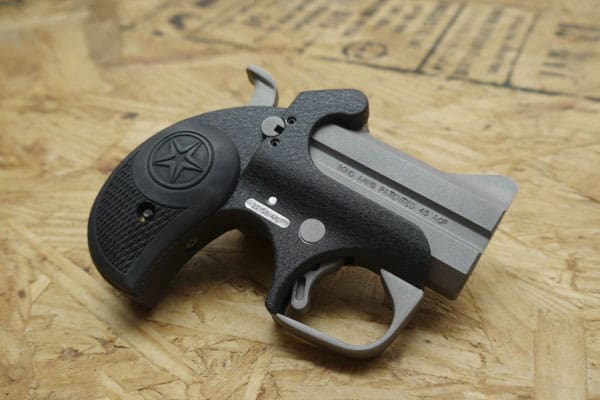
Many firearms enthusiasts consider the revolver the best firearm for concealment. While sub-compact semi-autos tend to be slimmer, the shape of the revolver’s frame and its grip’s slenderness offer huge advantages for deep concealment. That said, Bond Arms has the ideal solution: the derringer pistol.
The concept dates from the early 19th century: a small pistol with a single barrel designed to be as small and concealable as possible. A Philadelphia gunsmith by the name of Deringer made the gun famous. In 1866, Remington improved the design with the addition of a second barrel. Dubbed the “double derringer” it’s the general outline of the design we see here today.
The rear of the Bonds Arms backup is constructed like a normal single action-only compact handgun. There’s a small grip and an external hammer with an over-sized spur to make it easier to cock in a hurry. The grip on this version is rubberized, which is definitely appreciated.
Something interesting about the fire controls: there’s a safety. Normally the only safety on a single action only revolver is the fact that you don’t cock the hammer until you’re ready to shoot. The Bond Arms Backup sports a cross-bolt safety as well. The hammer will still fall with the safety engaged, but the firing pin (in theory) should not be struck. Pro tip: just keep the hammer de-cocked unless there’s trouble.
The Bond Arms Backup‘s barrel system is its party trick. Instead of a cylinder or magazine, the cartridge is loaded directly into the chamber (which is directly and permanently attached to the barrel).
The only way to fire a successive cartridge out of that barrel; disassemble the firearm, manually extract the casing, load a new cartridge, and re-assemble the firearm. It’s a lengthy process, made slightly less annoying by the second chance at hitting your target before needing to reload.
Disassembling the firearm is easy. There’s a lever on the left side of the frame that unlocks the barrels, which then swing out of position giving you access to the chambers. Re-assembly is also a snap. Just swing the barrels back into place and they firmly and securely snap closed, ready to fire.
If you don’t like your caliber you can change your caliber. The barrels can be removed and replaced. Our test gun shipped with both .45 ACP and 9mm barrels.
Two barrels mean two firing pins. To avoid two hammers and two triggers, the Bond Arms’ hammer is segmented. It alternates from one firing pin to the other with each pull of the hammer, just like an under/over shotgun. There’s no way to set the priority, other than to pull the hammer back once, release, and pull it back again.
On this model the frame and grip are black. The barrels are made from bead-blasted stainless steel to reduce visibility — good features on a concealed carry firearm. The sights are standard notch-and-post with the front blade built into the barrel and the notch part of the hinge mechanism. I appreciate that the notch and post are both part of the barrel, theoretically ensuring increased accuracy as everything remains aligned and fixed even while changing barrels.
I’m not going to sugar coat it: this thing is a nightmare to fire.
The mechanics alone are frustrating. Given the stiff spring, pulling the hammer to full cock takes some dedication. Once cocked, the trigger is crisp and relatively clean — and heavier to pull than Jabba the Hutt on a Red Ryder wagon.
I can understand why a company would make the trigger so heavy on a double action pistol. With two safeties — the single action nature and an actual cross-bar safety — why such a heavy trigger pull? It was difficult to keep the gun on target through the entire trigger pull for the first 50 rounds of ammunition.
Once the hammer falls things get worse.
With a normal-size handgun the firearm’s weight softens the recoil before the impulse reaches your hand. With the Bond Arms Back Up there’s almost no weight to the firearm. All of the energy is transferred directly to your hand. This is especially troublesome for those with large hands; there’s not much room between the grip and the rear of the trigger guard. Your knuckles get a rapping with each pull of the trigger.
Equally, any fingers in direct contact with any rigid and pointy bits on the gun take a beating. My right thumb had been resting near the takedown lever for a couple of rounds. The force of the recoil bashing into my thumb was enough to split the skin and start bleeding. Not the first (or last, probably) time a gun will take me to the first aid kit, but not something I’d like to do on a regular basis.
Accuracy is also an issue. I wasn’t able to hit the target at our usual testing distance of 30 feet. So I perforated the target above at 15 feet. I fired ten rounds (five from each barrel). As the rounds impacted the target I noticed that I didn’t have one group — I had two.
The top barrel was grouping higher than the bottom barrel, spreading in a different direction. The groups were even offset horizontally by a different ratio. In short, the barrels don’t seem to be all that well aligned. I wouldn’t trust the second round accuracy of this gun beyond bad breath distance.
There’s definitely a market for this gun. Super concealable firearms have been desirable since the early 1800s. Manufacturers keep coming back the “one barrel one bullet” approach to scratch that itch. At bad breath distances, this works.
That said, it isn’t for me. There’s just not enough grip for me to comfortably control the firearm while firing. There’s too much recoil to have an accurate follow-up shot. And while this might seem slightly hypocritical coming from someone who sometimes carries a 5-shot .38 Special revolver, two rounds are too few.
SPECIFICATIONS:
Barrel: 2.5″
Overall length: 4.5 inches
Available calibers: .45ACP or 9mm Luger
Weight: 18.5 ounces
MSRP: $490
RATINGS (Out of Five Stars):
Accuracy: *
The heavy trigger combined with the tiny form factor makes it very difficult to make an accurate shot. Plus, each barrel has a different point of impact.
Ergonomics *
Just awful.
Reliability * * * * *
Honestly the only thing that would impact the reliability of this thing is the ammunition. Everything else is well made and rock solid.
Overall * * *
If you need the smallest practical firearm possible for bad breath distance situations, look no further. Otherwise, look further.

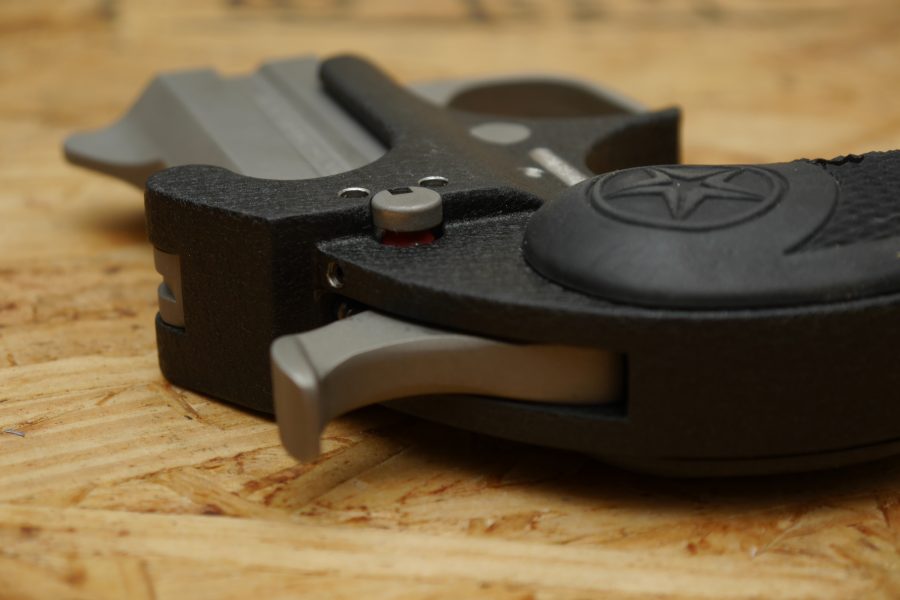
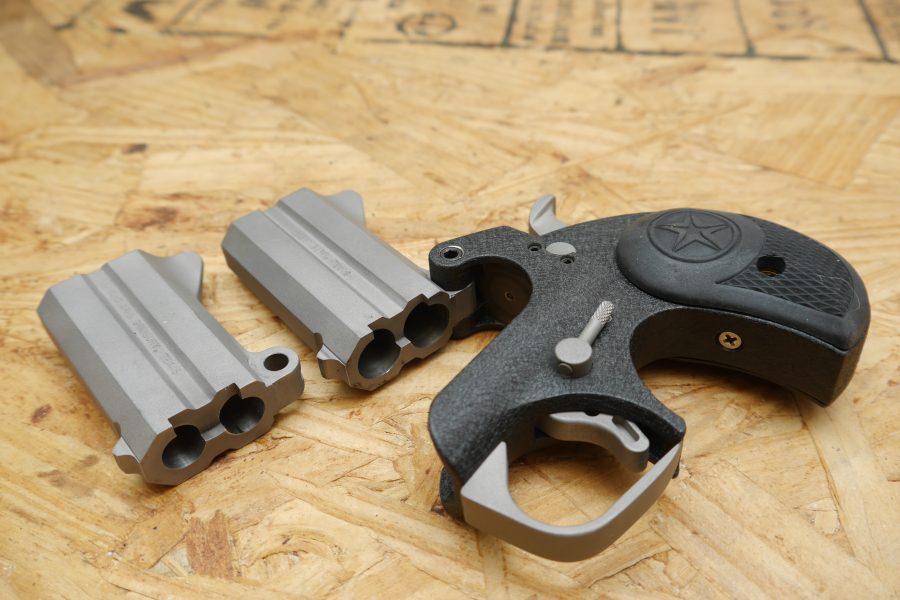
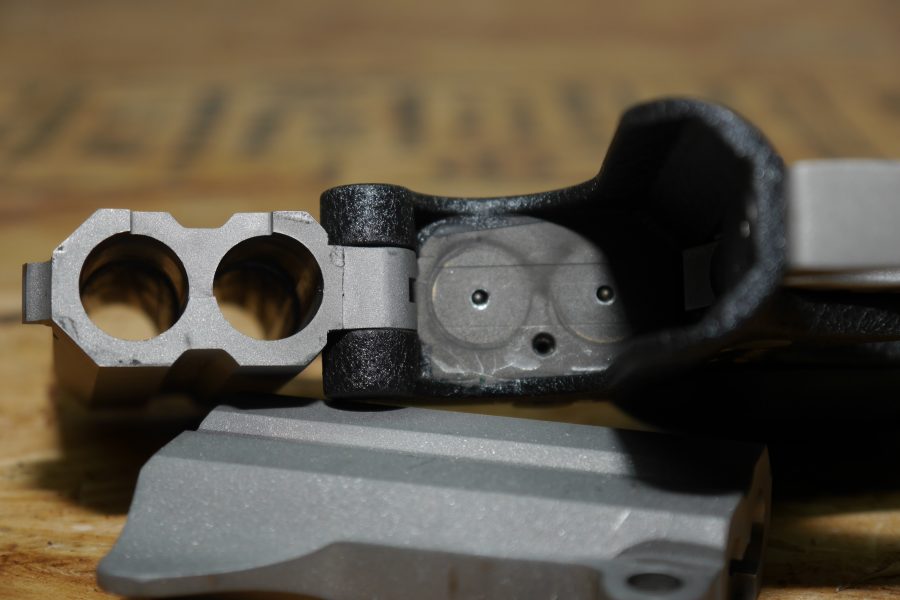
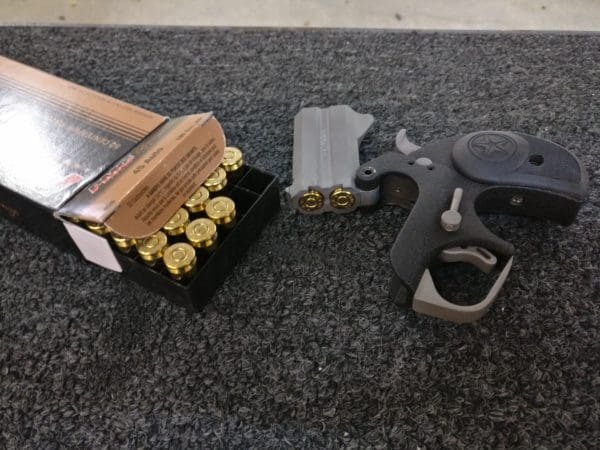

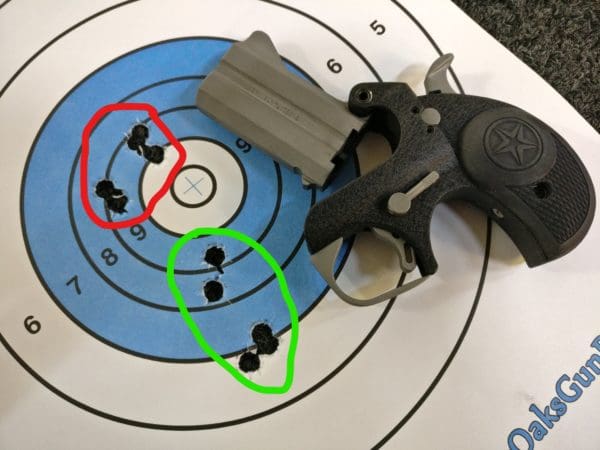




Did you test the 9mm barrels to see if the recoil was less than the .45 ACP?
I have the 9 millimeter version. To say that the recoil is brutal is an understatement. I can’t imagine firing full power 45 ACP loads out of this. I was firing subsonic ammo and it still felt like my hand was getting hit with a hammer every time I shot it at the range 12 pound trigger pull on more than one occasion I think I had accidentally engaged safety. the one redeeming Advantage is has is that it is about the size of a pack of cigarettes so it is very easy to conceal
“I have the 9 millimeter version. To say that the recoil is brutal is an understatement.”
Bond sells a 10mm barrel. (And a .410, and others).
How much worse would the 10mm be?
Have you ever spent time in a Turkish prison?
“i never saw a man take to a turkish prison so quickly.”
I have the 45 acp, roughneck, and honestly the recoil isnt bad, I cant understand why you are saying 9mm is more than brutal. Man up, it does have a little kick but it’s not bad, just make sure you have a proper and firm grip, I love my Bond Arms, 45 acp, will be getting a 45 long 410, 3 inch barrel for it. But stop telling people its brutal cause it is an easy firing little pistol.
Because they are sissies. I shoot 3 inch.410, and buffalo bore hafd cast.45 Colt in mine. Thwy need to drink milk or something.
From my unfortunate time with the DoubleTap Pocket Pistol, the difference between 9mm and .45 ACP is certainly noticeable. Out of that 0.665″ wide, aluminum-framed gun weighing in at 15 ounces, the recoil was entirely abusive. It was like getting hit in the palm by a ball peen hammer. Self-flagellation for sure. Hard not to fire off a string of four-letter words upon shooting it haha
I wish I still had it just for the schadenfreude of tricking people into shooting it.
I heard that the Double Taps were entirely abusive, including the 9mm. Accuracy & follow up shots really suffer (and you only have 2 to start with before a reload, if you survive). Again, this is where something like the Ruger LCP really shines; depending on the mag, 7 or 8 to start with & a quick reload with spare mag. Use ARX ammo in it & you have a hard hitting little gun with nominal recoil. I use the LCP as example of the ‘derringer’ for the 21st century.
https://www.youtube.com/watch?v=-783Aw9qXbc
What I’m having a tough time wrapping my (admittedly tiny) head around Jeremy, is *why* in the hell did Bond make the metal of the back of the frame come into direct contact with the shooter’s palm, insuring the recoil impulse (the *pain*) takes the path of least resistance to the palm?
Unless I’m missing something obvious (and I probably am), why didn’t Bond ‘isolate’ the pain a bit by having some rubber (a half inch or so) between the frame and the palm instead of on the sides of the grip?
I will come out and say it … it makes no sense whatsoever to construct a Derringer in .45 ACP. The short barrels mean the muzzle velocity will be, what, 550 fps? Then you have the punishing recoil that happens when you try to launch a 230 grain bullet.
I would expect a derringer to be chambered in a “light” caliber such as .25 or .32 or possibly even .380 ACP. I suppose you could even convince me to chamber a Derringer in 9 mm Parabellum. Anything beyond that is too punishing.
As for accuracy concerns, there should not be any since Derringers are a “contact” weapon.
I would be interested in a Derringer chambered in .380 ACP with a slightly longer barrel to develop adequate muzzle velocity. Oh, and the price would have to be closer to $200 since there isn’t much to them.
I am not endorsing this gun, but, according to QuickLoad’s guesstimates a 2.5″ barrel could move even a 230gr bullet to 760fps and that was without even trying to find the best powder for the application. It guessed just about 900fps for 185gr bullets.
Cobra makes one in several calibers, including standard pressure .38 special, .380, .32 ACP, .25 ACP, .22 mag, and .22 LR. They have ZAMAK frames (or at least the smaller caliber ones do, and I assume the larger caliber ones do as well). The 9mm, .38 SPL, and .380 are part of their “Big Bore” series and are almost exactly the same size as the original Remington derringer from the 1860’s (the smaller caliber ones are tiny enough to hide in the palm of your hand – I used to have the .22 LR version, and I liked it, but it was stolen from me. Not going to get into that story right now). I read a review of the .38 SPL version in an issue of “Guns of the Old West” (derringer side matches are popular in Cowboy Action Shooting), and IIRC it got a fairly positive review. THe price range is about what you are looking for, too.
These are sold to the people who refuse to carry a smaller cartridge, but really just need a pocket 380. They are heavier than an lcp, carry 6 fewer rounds, are about the same size, BUT they shoot .357, 45ACP, 9mm etc.
It’s a poor compromise in my opinion. ?
Not really!
$490!??!?! LOLWUT?
This type of gun does has value, but not above the $200 range. Personally I wouldn’t buy one unless it was were under $100.
They have been in business many years, so their guns are obviously worth the money to quite a few people.
Obviously you are right. And the market seems to support their pricing, but it’s too rich for the value I’m seeing from it.
Would need to roll in <$150 and realistically <$100 for me to consider using it. As smaller semis and revolvers are produced, it's relegated to backup to a backup.
I’m with you on this one. Just about every firearm out there has it’s niche market, and if people want to pay that much for this thing, more power to them.
To me though, these would be one of those novelties you buy at a gun show because you got a C-note burning a hole in your pocket. There are just so many other guns I’d want for the $400-500 range.
Really? What new item do you buy for $100. Of machined steel for $100.
“Well-built awfulness” is what I use to describe these.
Although I take exception with the descriptor “practical” in reference to derringers, it is impossible to argue that they do satisfy Rule 1 of a gunfight: “Have a loaded gun.”
Your mileage may vary.
The “Well-built awfulness” (the sheer mass) does go a long way in taming the bite.
The difference in the pain factor between shooting a steel and an ‘airweight’ snubbie is a stark example of this…
If the bottom barrel shoots lower than the top, it may be because of the lower bore axis rather than poor machining.
Just curious how the Bond shoots compared to the LCR. Being a .357 guy I’d like a small backup .357. I was thinking the Bond derringer might handle better because it weighs more, but maybe not.
I have the 4″ Ranger 2 in .357. I never shoot .357 out of it because it hurts so bad. .38 is all use when i want to shoot the gun. I prefer not to think of the pain a 2″ model would casue
The distance between the two groups is significantly larger than the spacing between the two barrels. It’s fair to say that they don’t pew projectiles on perfectly parallel paths.
Yes, they would be. I’m saying that if the two barrels were perfectly aligned the bottom barrel should shoot low because the bore axis is 3/4″ lower than the top barrel and the recoil shouldn’t cause as much barrel rise. How much this effect would be is beyond my pay grade, but I’d wager that the parallel is no more off up and down than it is side to side.
Sticking a laser bore sighter in both barrels could reveal the true out of parallel?
Props for the perfectly planned pulchritudinous alliteration.
Wait! You gotcher one uh them fancy edumacations?
Well, Gov, I’d have to agree lasers would be the only way to settle that argument short of figuring out how to cram this rascal into a Ransom Rest.
As for what it’s practical for: Nothing. And that’s kind of the point. Bond Arms actually has a small but dedicated following that simply appreciates their sheer quality. I’ve often described their slightly larger Snake Slayer in .410/.45 colt as “the most useless gun I’d actually carry” to customers… it’s sort of a novelty thing and not intended to actually take the place of a more practical EDC or pocket pistol. Thus, any review of a Bond Arms derringer needs to be viewed with a lighter heart. That said, Bond missed their own point on this one… pass.
‘the most useless gun I’d actually carry’. – I like it. Probably a dozen or two other handguns you could use that line for.
A Ruger LCR revolver or especially LCP semi auto has a whole lot more firepower, accuracy, ease of use & tamer recoil than these things in about the same size package. To me it is just a novelty that I am over.
One advantage the derringer does have over a compact re volver or pis tol is a longer barrel for equal length fir earms. Judging by Shootingthebull’s videos, (for instance) a 3″ barrel is as short as you can go and still get reliable expansion in 9mm. 2-1/2″ seems too short to me, but if the gun works, a 3″ or 3-1/2″ derringer might make sense to some over an LCR or LCP.
Short barrel and poor expansion of hollow points is more of a problem with either weak/slow/underpowered cartridges like .25 ACP, .32 ACP, .32 S&W, etc. and semi auto pistol cartridges. Revolver cartridges .32 H&R Magnum and up have bullets meant to expand from short barrels of snub revolvers.
While longer barrels can be put on a derringer, it doesn’t do much good. Even with a 4 inch barrel, the derringer is not an accurate handgun, it’s ergonomically poor design is uncomfortable to shoot and the sights are crap.
327 Federal would be about perfect for this gun. 32 S&W, 32 H&R, and 32 Fed could be shot though it. Find your comfort level and carry that load.
Rev olver ro unds also have the advantage of being able to use semi-jacketed hollow points, which theoretically should expand more reliably than the jacketed hollow points used in semi-autos.
I wouldn’t expect longer barrels to have any advantage other than bul let velocity and with it reliable expansion.
If you use Polycase Ruger ARX ammo you can have your cake & eat it too. No, the ARX has no expansion, but the hydraulic displacement from the fluted bullet spinning @ 3 thousand RPM is amazing. Got to test it for yourself. In .380 ACP, 9mm Luger, 38 Spl, .357 Mag & .45 ACP so far. Use the ARX in LCP Custom & LC9S, have too much Remington 125 gr JHP +P for the LCR to switch, but the Rem out of the LCR does quite well.
Don’t see .357 magnum on Ruger’s ARX page.
By my math, using 9 mm at 1400fps with a 10″ twist those have to be spinning around 100,000rpm. While I’m intrigued with this technology there are two things I can see that could be problematic. One is that an 80gr. 9 mm bu llet will lose velocity and energy much faster than a 124gr. bul let, so it’s probably not the best am mo for longer ranges. Second is that rotational velocity would have to decelerate rapidly on contact, so I would think the worst of the damage would be in shallow tissue with the bull et turning into more of a FMJ in deeper tissue. I’d have to see some ballistic gel tests though. Could very well be the perfect solution for short barrels.
I did not make it clear that all ARX ammo is not Ruger branded; some are just Polycase, the parent company. Go to Polycase’s website for some good info, ballistic gel tests & all. No, not for long range; we are talking up close & personal self defense uses. My own tests on water jugs has been very impressive & fun. I use enough paper after the water jug to retain the bullet for examination. Imagine a heavy 5 quart oil jug shot with a LCP Custom .380 ACP/ARX that looks like it was hit with a good 9mm or 38 Spl JHP. Good stuff.
Personally my edc is a .357 revol ver in part because I want a carry gun that can reach out a bit. I also got to thinking that those flutes would be pumping air out laterally as it flies to the target, shedding energy along the way. I don’t see any exterior ballistic tables or ballistic coefficients, even on the hu nting line, so I’m guessing it’s a horrible long range round, but it does make some sense in a pocket gun.
No,the flutes do not cause aero loss, I have enquired into that. However, they have not responded back about the .357 on long range or fired out of a rifle. I think the low mass would be more of a ballistic loss than anything. I have so much 38 +P & .357 Mag ammo it does not matter, but I am curious to know. (That feeds a GP100, two SP101s, an LCR & 77/357 rifle). But like I said, the ARX from a short barrel pistol at self defense distances gives dramatic results. The 9mm will shoot thru a car door (if it does not hit something big like a window motor) & still do the job on a perp. I do use other ammo than the ARX in self defense guns, depending on application: Magtech 124 gr JSP in a 9E (woods/property carry), Magtech 124 gr BJHP in a SR9C (home invasion), American Eagle 158 gr JSP GP100 (woods gun), Magtech 125 gr JHP (wife’s SP101). A real eye opener is 158 gr JSP or JHP from 77/357 rifle. At 50 yards will blow a sealed STEEL bucket with steel lid & lock ring filled with water completely apart and with what I call the reverse concussion breaking the 2x4s the bucket is sitting on. Got to see it to believe it. I do not think ARX would do that I am am too cheap to buy some to test it out since I have a bunch of the regular stuff. Polycase has not answered me on the .357 ARX.
“hydraulic displacement from the fluted bullet spinning @ 3 thousand RPM is amazing. ”
Is there real data that shows this actually occurs? I like the ARX rounds for sub guns purely because of their accuracy, but I would need some very solid evidence that says there is any significant fluid displacement at all beyond the bullet diameter once the round contacts something. With the low mass of the round relative to a human body, I bet it stops spinning almost immediately.
While a bullet rotating at 100,000 rpm sounds horrifying and impressive (Ripping through flesh like a saw!), in application a bullet usually rotates once or twice max.
The Demanding Moms, however, like the imagery of “Ripping through flesh like a saw!”…
You’re right Geoff, I calculated that 100,000rpm number using Ruger’s 10″ twist rate for the LC9 (actually at advertised velocities it was around 116,000rpm). They claim 11.25″ of penetration from the 9mm round so yea, 1.125 revolutions before the spinning comes to a dead stop.
Eh, a couple hundred more and you could have one of the nicer Bond derringers. I’ve been eyeing the Rustic Ranger as a boot-concealed church gun.
I use a Ruger LCP Custom for that purpose; smaller, lighter, more firepower, more accurate, less expensive. Actual utility verses looks, and don’t forget having spare mags for quick reloads. The derringer just does not cut it, neither do the NAA mini revolvers.
If I wanted a utilitarian carry gun for church I’d stick with my M&P 9c (which is not boot carried). I just want something fancy that still keeps me armed. It’s more of a “want” gun than a “need” gun.
There we go again with needs & want thing. Seems we all enjoy the ‘wants’. I really wanted a derringer & a mini revolver. Myself, I can not shoot a derringer or mini revolver well enough to risk using. My LCR. LCP, LC9S, etc no problem. Got to make sure you can actually hit your target.
For $600+, that Rustic Ranger must be a very nice derringer, indeed. I can’t see spending that for a “two shots and then throw it at the guy” gun, no matter how pretty the wood grips are.
But if it’s concealed, why buy the fancy one? You don’t tuck your pants into your boots for church, do you?
Why buy lingerie for your wife if she’s only gonna take it right off again, when regular granny panties will do just fine? Some things are pretty for the sake of being pretty.
The trigger pull on every Bond Arms Derringer I’ve ever shot, and I’ve shot dozens, is pretty light. But there is definitely a trick to it, actually two. First, your hand can’t be making any contact with the hammer at all. At all. If so, it will radically increase the trigger pull. Second the trigger mechanism doesn’t really pull back but actually slightly down. If you pull back it’s really hard, if you stroke it down it’s very easy.
It’s a really fun gun and I love mine. I boot carried one in .410 for deep concealment for a while. But there are some nuances to make it work.
Thanks for the honest review. Looks I’ll be sticking with the LWS32 – I can accept the weaker loading for a package that’s smaller, lighter, higher capacity, semiauto, easier/less painful to shoot, and costs about the same.
I had been thinking of eventually getting a Patriot (larger grip) in .45acp or gap with a 3″-3.5″ barrel. (They said you can buy it in the .45lc/.410 and then trade in the barrel for whatever caliber you like (restocking fee applies I think).) Not sure if this review makes that more or less likely.
I didn’t mean to imply that I do the reverse of what Nick says. In fact, I have spent many hundreds of dollars based on his recommendations. I didn’t read this as a particularly negative review and kept Jon’s earlier experience in mind with a different model as I read it.
One of the things that I appreciate about this website is that two reviewers can have totally different experiences with the firearm and both are printed. My experience with the Bond Arms derringers have been extremely positive, Mr. Leghorn’s clearly negative. Both are completely valid. It really highlights what the individual shooter gets out of each gun. http://www.thetruthaboutguns.com/2016/04/robert-farago/gun-review-bond-arms/
The reviewer says that opening the action constitutes disassembly.
Any “gun writer” with such a feeble grasp of firearm mechanics is not to be given much consideration.
Any Ruger, S&W, Charter snub revolver > Bond Arms derringer.
Not hating on the company, they make good stuff, but the derringer itself is not better suited for self defense than a snub revolver.
Always thought that I really wanted a Derringer, but I came to realize that they are not practical compared to a snub nose revolver or pocket .380 ACP. In place of the Derringer I chose a Ruger LCR .357 & LCP Custom. I consider the LCP to be a modern day equivalent of the derringer.
I get that it is super reliable and easy to conceal. But with the reliability and concealability of modern revolvers and semi autos holding 5-7 rounds this seems like a rather pointless and outdated design.
Add to that the huge honking hammer that gets hung up, no thanks.
Pro tip: on a single action without a transfer bar, either use the provided safety or keep a chamber unloaded. Single actions with the hammer down without those conditions are NOT drop safe.
The Bond Arms Derringer is CA compliant and approved, which includes drop safe testing.
Last I knew they had developed a special version for CA. I think that it could not have interchangeable barrels.
My reply was to the over generalized statement of hammer down on single actions. However, with the derringer designs the only thing stopping it from firing is a rebounding hammer (also the reson they have crappy triggers). Usually stored in a pocket full of lint and without maintenance they develop a trigger reset issue which affects it’s only safety. As far as the CA drop test, go read the procedure. It’s developed to make money and eliminate low hanfing fruit. Just to let you know I’m not biased, I also believe the manual safety on a 1911 is redundant.
Poor accuracy, killer recoil, ridiculously heavy trigger, extra time required to cock, only two shots, extra safety to have to manipulate. What is there to recommend this gun shaped object? For two thirds the MSRP you can get a Ruger LCP or an even cheaper Kel Tec. Each is only an inch larger than this thing, has more shots, is more accurate, quickly reloadable.
You see Petrushka, it’s like this:
Have you ever been in an intimate relationship with someone where putting up with their crap and bulls*it was worth it in the end for what you wanted?
It’s a lot like that 🙂
that covers all of mine.
long term relationships consist of individuals that keep not breaking up repeatedly.
“That said, Bond Arms has the ideal solution: the derringer pistol…”
Did the author of this sentence read the rest of the article?
I’ll stick with a tiny 380 for concealmet…or even a Keltec 32. Pretty little..
So no 45/70 derringer for u guys, huh? There is such a beast. Google it
This is a firearm you can drop down the front of your speedo, give you a friendlier look too, maybe.
I would rather have a 5 shot .22 mag naa or a Beretta .25 or .32 if concealment was that much of an issue.
This just looks awkward and only 2 shots. Meh.
Picked up a Bond Arms Texas Defender in 45 / 410 when I moved to Nevada. Put a bigger grip on it. It is my snake gun when I go out and about the rangeland. Also carry something else in the event that a more significant threat presents itself.
John Browning determined that the 45acp needed a full size grip to control recoil. I see no point to a one finger grip, stiff single action hammer and monster trigger. And all that for 2 shots?! Several .38 revolvers weigh about the same, offer 2 1/2′ times the capacity and are much more manageable and less abusive. There was a reason the original Remington double derringer chambered the anemic .41 rimfire. If you want something like this, get a .22 or maybe a .32.
Gear up as your favorite Delsin Rowe Vest. Slim Fit Leather Jackets brings this iconic jacket from animation to reality, especially for all the fans of this video game. Delsin Rowe is the main protagonist and playable character, a young Native-American man who later realizes he’s a Conduit with special powers.
Comments are closed.